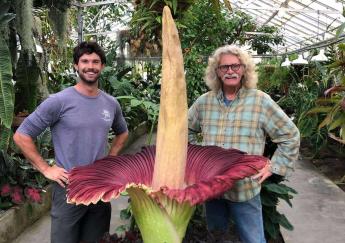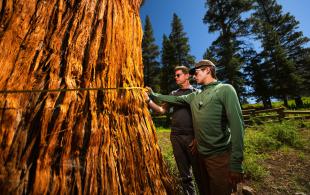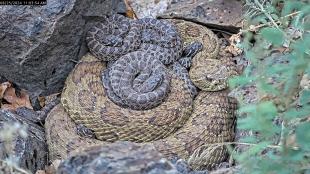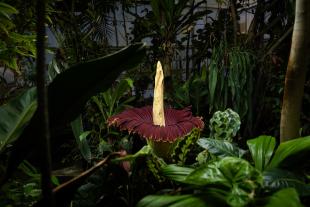Back to Back Blooms: Another Corpse Flower Comes Alive For Third Straight Summer


For the third consecutive summer, a corpse flower bloomed in spectacular fashion on the Cal Poly campus.
The latest bloom came from a 7-year-old corpse plant named Mustito. Corpse plant blooms are usually rare, and can take several years of growth to achieve.
The corpse plant, also called titan arum, makes the world’s largest unbranched inflorescence (cluster of flowers), but flowering is rare. The bloom can grow to more than 8 feet in height and over 3 feet in diameter.
When it flowers, the plant makes a huge stinky maroon funnel, called the spathe, with tiny flowers borne on a huge spike, which is called the spadix. The spathe sends a foul aroma into the still forest air for 24 hours to attract pollinators, then closes up.
Mustito, which flowered July 25-27, is a sibling of the first corpse plant to bloom at Cal Poly, dubbed Musty. In the summer of 2020, 3,000 people came out to see and smell Musty, then six years old, in all its glory.
The bloom streak continued last summer when a different corpse plant, Bertha, produced its own stinky flower when it was nearly 18 years old.
“We have corpse plants that are ranging from five to almost 20 years old, and they bloom randomly, so it's really hard to tell when that’s going to come,” said Matt Ritter, a biological sciences professor and director of the Cal Poly Plant Conservatory. There are about a dozen corpse plants currently being cultivated at the university.

This year’s bloom had a limited audience. A few people who heard of the spectacle dropped by Cal Poly's Horticulture Unit to observe the unusual flower.
“They have been rare to see in the USA (and around the world) yet over the past 10 to 15 years, more and more universities and public gardens have been growing and displaying them,” said Mike Bush, a retired Cal Poly horticulture lecturer who still works at the Horticulture Unit. “This is a product of more begets more as we all tend to share pollen.”
Want more Learn by Doing stories in your life? Sign up for our monthly newsletter, the Cal Poly News Recap!




